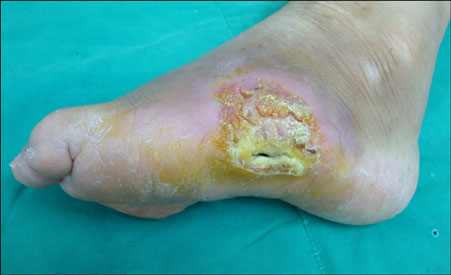Ann Dermatol.
2011 Feb;23(1):70-72. 10.5021/ad.2011.23.1.70.
A Case of Reactive Eccrine Syringofibroadenoma
- Affiliations
-
- 1Department of Dermatology, College of Medicine, The Catholic University of Korea, Seoul, Korea. drchos@yahoo.co.kr
- KMID: 2171956
- DOI: http://doi.org/10.5021/ad.2011.23.1.70
Abstract
- Eccrine syringofibroadenoma is a rare adnexal tumor of eccrine ductal differentiation with variable clinical features. It manifests as either a solitary or multiple papules and nodules arranged in a symmetrical or linear pattern. The anatomical distribution is wide and includes the face, trunk, extremities, and rarely the nails. Histopathological findings show anastomosing cords and strands of uniform cuboidal cells surrounded by fibrovascular stroma. Herein, we report a case of reactive eccrine syringofibroadenoma which developed on the foot of a 37-year-old woman, after self-paring of tissue and subsequent infection and ulceration.
Figure
Cited by 2 articles
-
Eccrine Syringofibroadenoma in a Patient with Long-Standing Exfoliative Dermatitis
Eun Jung Ko, Kui Young Park, Hyun Jung Kwon, Joo Hyun Shim, Seong Jun Seo
Ann Dermatol. 2016;28(6):765-768. doi: 10.5021/ad.2016.28.6.765.Eccrine Syringofibroadenoma Associated with Bowen's Disease: A Case Report and Review of the Literature
Ji Su Lee, Hyunsun Park, Hyun-Sun Yoon, Soyun Cho
Ann Dermatol. 2020;32(1):57-63. doi: 10.5021/ad.2020.32.1.57.
Reference
-
1. Starink TM. Eccrine syringofibroadenoma: multiple lesions representing a new cutaneous marker of the Schopf syndrome, and solitary nonhereditary tumors. J Am Acad Dermatol. 1997. 36:569–576.
Article2. French LE. Reactive eccrine syringofibroadenoma: an emerging subtype. Dermatology. 1997. 195:309–310.
Article3. Utani A, Yabunami H, Kakuta T, Endo H, Shinkai H. Reactive eccrine syringofibroadenoma: an association with chronic foot ulcer in a patient with diabetes mellitus. J Am Acad Dermatol. 1999. 41:650–651.
Article4. Ichikawa E, Fujisawa Y, Tateishi Y, Imakado S, Otsuka F. Eccrine syringofibroadenoma in a patient with a burn scar ulcer. Br J Dermatol. 2000. 143:591–594.
Article5. Poonawalla T, Xia L, Patten S, Stratman EJ. Clouston syndrome and eccrine syringofibroadenomas. Am J Dermatopathol. 2009. 31:157–161.
Article6. Mascaro JM. Considerations on fibro-epithelial tumors. Exocrine syringofibradenoma. Ann Dermatol Syphiligr (Paris). 1963. 90:143–153.7. Mattoch IW, Pham N, Robbins JB, Bogomilsky J, Tandon M, Kohler S. Reactive eccrine syringofibroadenoma arising in peristomal skin: An unusual presentation of a rare lesion. J Am Acad Dermatol. 2008. 58:691–696.
Article8. Tey HL. Characterizing the nature of eccrine syringofibroadenoma: illustration with a case showing spontaneous involution. Clin Exp Dermatol. 2009. 34:e66–e68.
Article9. Cho HS, Kim WH, Kim CW, Kim KH, Kim KJ. A case of eccrine syringofibroadenoma associated with squamous cell carcinoma. Korean J Dermatol. 2005. 43:1635–1638.
- Full Text Links
- Actions
-
Cited
- CITED
-
- Close
- Share
- Similar articles
-
- Eccrine Syringofibroadenoma: A Case Report
- A Case of Solitary Eccrine Syringofibroadenoma
- A Case of Solitary Eccrine Syringofibroadenoma on the Left Inframammary Area
- Eccrine Syringofibroadenoma in a Patient with Long-Standing Exfoliative Dermatitis
- Eccrine Syringofibroadenoma Arising from Nevus Sebaceous



